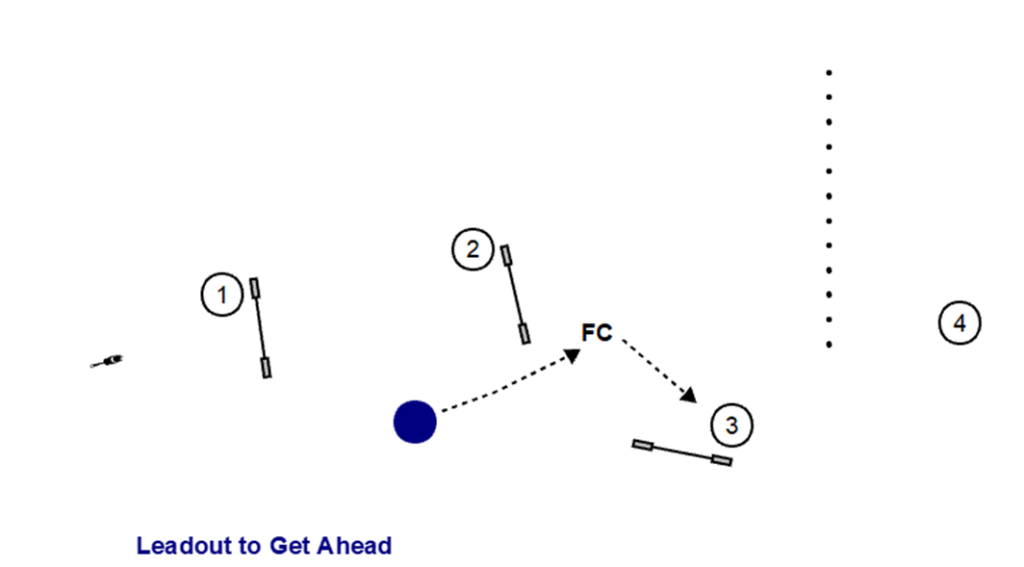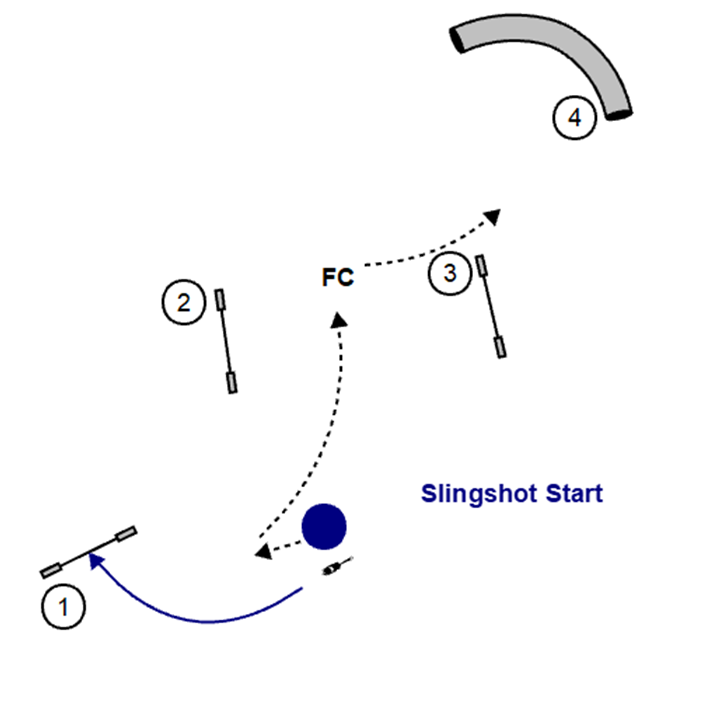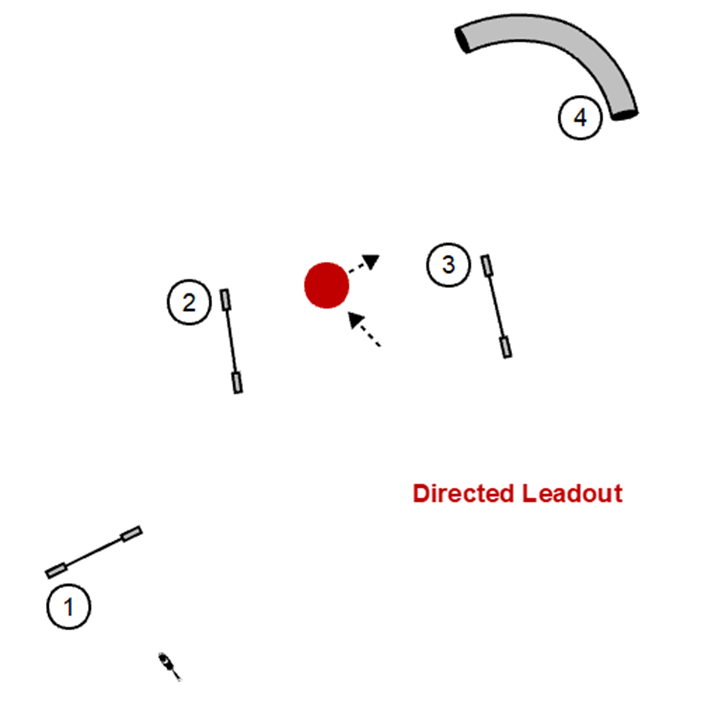This page features information on using lead outs and developing start line behaviors. You’ll find foundation drills, short sequences, handling advice and more.
Sign up for our newsletter to stay up-to-date on new resources.
Start Line Routines
A Start Line Routine is a combination of consistently used and reinforced behaviors that benefit you and your dog’s state before beginning an agility run.
The behaviors that benefit you and your dog pre-competition depend on you, your dog and your relationship. Teams we’ve worked with in the past have benefited from heeling into the ring, using fun tricks on the start line before setting up, or using a specific position to set their dog up. Positions such as sitting in heel, sitting between your legs or coming to a front position can provide the handler the ability to angle the dog appropriately for the first obstacle with ease.
Regardless of which behaviors you use, remember that you need your dog to have a positive association with entering the agility ring. We recommend consistently using and rewarding your dog for their start line routine in practice.
If your dog is nervous in the ring, please refrain from coercing your dog with food or other rewards towards a stressor. When we pair a reward with a negative we can reduce our dog’s positive association with that reward and decrease their motivation for that reward. If your dog is over-excited, please refrain from corrections (e.g. leash popping, physically manipulating your dog away from the ring, etc.). We know both of these scenarios can be challenging, training and practicing a specific start line routine can help. You may need to teach additional life skills or practice in various environments that simulate competition to help your dog set up confidently while demonstrating self control.
Why use a Start Line Routine?
We recommend having a consistent start line routine for your team. Consistency in the actions you take right before your run provide your team with the following benefits.
1. Start Line Routines provide familiarity for your dog in unfamiliar environments.
We’re always looking to make practice more like competition and make competition more like practice. Lots of what we do in training can’t come into the competition ring with us! Training aids, like targets, mats or clickers, along with rewards aren’t allowed in the ring. While agility venues allow toys in the ring with an FEO (for exhibition only) or NFC (not for competition) option, we are still limited on how we can help our dogs transfer skills from practice to a real trial.
A start line routine is one thing that you can make consistent for your dog regardless of the environment! Being consistent in our actions helps your dog trust you more and be more confident in their environment.
2. A Start Line Routine can boost your mental game.
Routines help you manage your energy, ignore distractions and focus on what is important – your dog! Letting our minds wander too far or focus on negatives before a run can be detrimental to our performance on course. A stressed mind has trouble concentrating, reacting, remembering, and performing complex tasks; all skills we need for agility. But, anyone that’s tried meditating knows how hard it can be to focus on nothing. Giving yourself a task or series of tasks to focus on can bring you to a state of mindfulness. This is especially true when those tasks are chosen intentionally. Be sure to include behaviors you find enjoyable and relaxing into your start line routine.
3. A Start Line Routine helps you judge your dog’s state.
If your dog is struggling to complete basic behaviors before your run, you may find that they are already over aroused or operating outside their comfort zone. This means before the run started, they were already having trouble concentrating. By paying attention to your dog’s behavior you gain insight on what skills they still need and how to help them transfer agility behaviors from practice to competition.
Skills for Lead Outs
While lead outs can serve different functions on course, to use any lead out your dog must have the following two skills.
1. Reliable Stay and Release
Your dog needs to understand how to stay in a position for a duration of time and understand a cue releases them forward. Often broken stays aren’t due to a poor sit stay, but instead confusion over what cue is the release. The stay behavior can deteriorate when handlers are inconsistent about using a release verbal cue, like “Okay” or “Break”, or when handlers allow the dog to break on other cues, such as motion or hand placement.
Consider what cues you use for each of these behaviors, the stay and the release, and be consistent about using your cues regardless of the environment. Whether you’re at home, at agility class or stepping into the ring at agility nationals, your stay cue and release cue should be the same everywhere!
Other factors that may impact your dog’s ability to stay include the environment, the course layout, or their arousal/stress level.
2. Obstacle Commitment
Regardless of the size of your lead out, when leading out you need to be sure your dog will commit to the first obstacle with you at a distance. This can be easy if the dog is set up directly in front of the obstacle. However, an angled approach might challenge your dog’s ability to commit to the first obstacle. By reinforcing your dog’s obstacle commitment and independence you can increase there ability to complete a variety of lead outs
Lead Out Purpose
Lead outs can serve one of two purposes on course, you can lead out to get ahead or lead out to set a line.
When leading out to get ahead the handler will go into motion as soon as the dog is released. This type of leadout allows the handler to run in front of the dog to start on course. Leading out to get ahead can be helpful on long lines or if there is a handling point early on the course the handler needs to get to before the dog. Lead outs to get ahead usually require a shorter lead out distance and benefit teams various dog-handler speed ratios.
When leading out to set a line the handler leads out to a handling point, such as a cross or turn on course, and will wait until the dog has responded to their handling before moving. This can help handlers eliminate issues related to timing when executing cues at a handling point. For example, you can’t be late to a front cross if you lead out and complete the cross before releasing the dog. Being in position before releasing the dog can require a longer lead out, but not always. These lead outs benefit teams where the dog is faster than the handler and dogs that need extra information for turns.
If you’re one of our agility students you’ll often hear Diane or Kathleen ask, “What’s the purpose of your lead out?” This is because we want to make sure your handling mechanics are correct for the effect you’re looking to get by leading out.
You cannot lead out to get ahead AND set a line at the same time. The handler must go into motion to get ahead OR stay in position until the “new” line is set. Checking in on your lead out purpose can help save you and your dog a lot of confusion!
Lead Out Types
Below you’ll find examples of common lead outs used on course.
Lead Out to Get Ahead
This is a classic lead out to get ahead. The handler leads out a comfortable distance, and goes into motion as they release the dog. This will allow the handler to execute the front cross before the dog takes off for the second jump. The lead out distance required depends on the dog-handler speed ratio.

Slingshot Start
While this start doesn’t require a sit-stay like most lead outs, using a slingshot start can allow the handler to get ahead. The handler will start next to the dog on an angle from the first obstacle and sends the dog from a distance. The distance in this send to the jump creates space for the handler to get ahead for a handling point later on the course. The distance required for this type of start depends on the dog-handler speed ratio and the course flow.

Lead Out to Set a Line
This is a classic lead out to set a line. The handler leads out to a handling point, in this case a front cross between the second and third jump. They get into position before they release the dog. This will allow the handler show information about the turn before the dog takes off for the second jump.

Directed Lead Out
This is an advanced lead out to set a line. The handler leads out to a handling point that is off set from the dog’s line. They cue the dog to release forward from a distance and then show information about the handling point; in this case, a front cross between the second and third jump. This lead out can eliminate timing issues for handing, however directed lead outs require a high level of obstacle commitment and independence.

